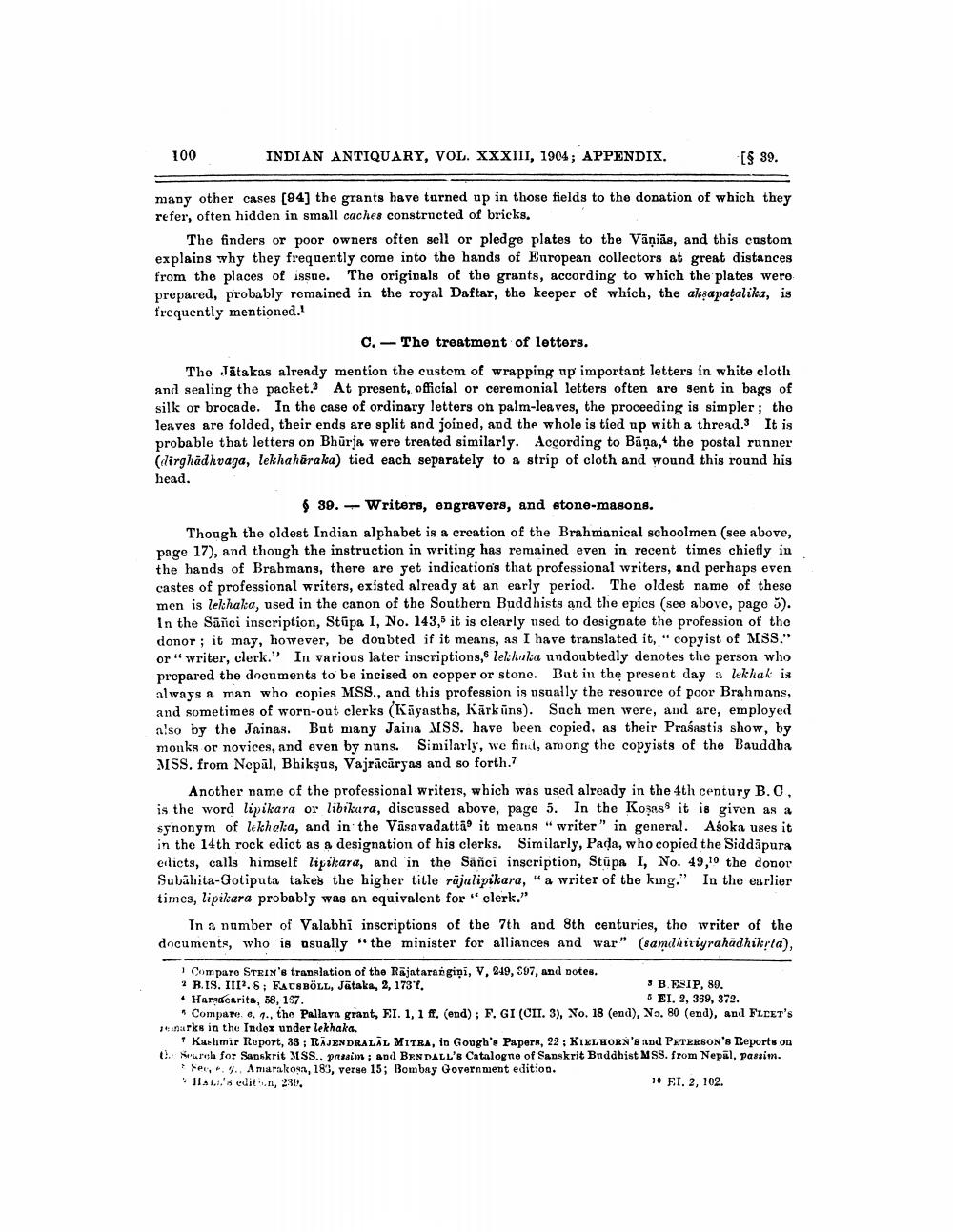________________
100
INDIAN ANTIQUARY, VOL. XXXIII, 1904; APPENDIX.
[$ 39.
many other cases (94) the grants have turned up in those fields to the donation of which they refer, often hidden in small caches constructed of bricks.
The finders or poor owners often sell or pledge plates to the Vāņiās, and this custom explains why they frequently come into the hands of European collectors at great distances from the places of issue. The originals of the grants, according to which the plates were prepared, probably remained in the royal Daftar, the keeper of which, the aksapatalika, is frequently mentioned.!
c. - The treatment of letters.
The Jātakas already mention the custom of wrapping up important letters in white cloth and sealing the packet. At present, official or ceremonial letters often are sent in bags of silk or brocade. In the case of ordinary letters on palm-leaves, the proceeding is simpler; the leaves are folded, their ends are split and joined, and the whole is tied up with a thread. It is probable that letters on Bhūrja were treated similarly. According to Bāņa, the postal runner (dirghādhvaga, lekhaharaka) tied each separately to a strip of cloth and wound this round his head.
39. Writers, engravers, and stone-masons. Though the oldest Indian alphabet is a creation of the Brahmanical schoolmen (see above, page 17), and though the instruction in writing has remained even in recent times chiefly in the hands of Brabmans, there are yet indications that professional writers, and perhaps even castes of professional writers, existed already at an early period. The oldest name of these men is lekhaka, used in the canon of the Southern Buddhists and the epics (see above, page 5). In the Sāñci inscription, Stūpa I, No. 143, it is clearly used to designate the profession of the donor ; it may, however, he doubted if it means, as I have translated it, "copyist of MSS." or writer, clerk." In various later inscriptions, lekhaka undoubtedly denotes the person who prepared the documents to be incised on copper or stone. But in the present day a lekhak is always a man who copies MSS., and this profession is nsually the resource of poor Brahmans, and sometimes of worn-out clerks Kāyasths, Kārkūns). Sach men were, and are, employed niso by the Jainas. But many Jaina MSS. have been copied, as their Prasastis show, by monks or novices, and even by nuns. Similarly, we final, among the copyists of the Bauddha MSS. from Nepāl, Bhikşus, Vajrācāryas and so forth.7
Another name of the professional writers, which was used already in the 4th century B. O, is the word lipikara or libikura, discussed above, page 5. In the Koşase it is given as a synonym of lekheka, and in the Vása vadatta it means "writer" in general. Asoka uses it in the 14th rock edict as a designation of his clerks. Similarly, Pada, who copied the Siddapura edicts, calls himself ligikara, and in the Sāñci inscription, Stūpa I, No. 49,10 the donor Sabāhita-Gotiputa takes the higher title rājalipikara, "a writer of the king." In the earlier times, lipikara probably was an equivalent for "clerk."
In a namber of Valabhi inscriptions of the 7th and 8th centuries, the writer of the documents, who is usually “the minister for alliances and war" (samdhiriyrahādhikrta),
Comparo STEIN'S translation of the Rajatarangipi, V, 249, 997, and potes. 3 B. IS, III.5; EA USBÜLL, J@taka, 2, 173f.
9 BESIP, 89. • Hargacarita, 58, 197.
• EI, 2, 359, 379. * Compare. e... the Pallava grant, El. 1, 1 ff. (end); F. GI (CII. 3), No. 18 (end), No. 80 (end), and FLCET'S narks in the Index under lekhaka.
i Kuhmir Report, 33 ; RAJENDRALAL MITRA, in Gough'e Papers, 22; KIEL HORN's and PETERBON'S Reports on t. Surel for Sanskrit MSS.. parsim ; and BENDALL's Catalogne of Sanskrit Bnddhist MSS. from Nepal, passim.
Sec. 4. Amarakona, 183, verse 15; Bombay Government edition. HAL's edit , 239
10 FI. 2, 102.




